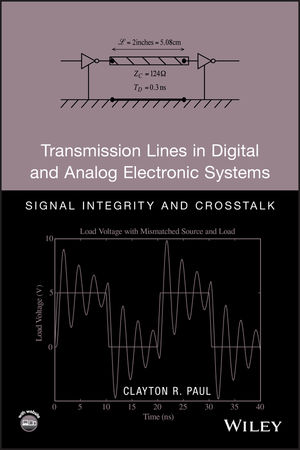Transmission Lines in Digital and Analog Electronic Systems: Signal Integrity and CrosstalkISBN: 978-0-470-59230-4
Hardcover
312 pages
September 2010
 This is a Print-on-Demand title. It will be printed specifically to fill your order. Please allow an additional 10-15 days delivery time. The book is not returnable.
|
||||||
Preface xi
1 Basic Skills and Concepts Having Application to Transmission Lines 1
1.1 Units and Unit Conversion 3
1.2 Waves, Time Delay, Phase Shift, Wavelength, and Electrical Dimensions 6
1.3 The Time Domain vs. the Frequency Domain 11
1.3.1 Spectra of Digital Signals 12
1.3.2 Bandwidth of Digital Signals 17
1.3.3 Computing the Time-Domain Response of Transmission Lines Having Linear Terminations Using Fourier Methods and Superposition 27
1.4 The Basic Transmission-Line Problem 31
1.4.1 Two-Conductor Transmission Lines and Signal Integrity 32
1.4.2 Multiconductor Transmission Lines and Crosstalk 41
Problems 46
Part I Two-Conductor Lines and Signal Integrity 49
2 Time-Domain Analysis of Two-Conductor Lines 51
2.1 The Transverse Electromagnetic (TEM) Mode of Propagation and the Transmission-Line Equations 52
2.2 The Per-Unit-Length Parameters 56
2.2.1 Wire-Type Lines 57
2.2.2 Lines of Rectangular Cross Section 68
2.3 The General Solutions for the Line Voltage and Current 71
2.4 Wave Tracing and Reflection Coefficients 74
2.5 The SPICE (PSPICE) Exact Transmission-Line Model 84
2.6 Lumped-Circuit Approximate Models of the Line 91
2.7 Effects of Reactive Terminations on Terminal Waveforms 92
2.7.1 Effect of Capacitive Terminations 92
2.7.2 Effect of Inductive Terminations 94
2.8 Matching Schemes for Signal Integrity 96
2.9 Bandwidth and Signal Integrity: When Does the Line Not Matter? 104
2.10 Effect of Line Discontinuities 105
2.11 Driving Multiple Lines 111
Problems 113
3 Frequency-Domain Analysis of Two-Conductor Lines 121
3.1 The Transmission-Line Equations for Sinusoidal Steady-State Excitation of the Line 122
3.2 The General Solution for the Terminal Voltages and Currents 123
3.3 The Voltage Reflection Coefficient and Input Impedance to the Line 123
3.4 The Solution for the Terminal Voltages and Currents 125
3.5 The SPICE Solution 128
3.6 Voltage and Current as a Function of Position on the Line 130
3.7 Matching and VSWR 133
3.8 Power Flow on the Line 134
3.9 Alternative Forms of the Results 137
3.10 The Smith Chart 138
3.11 Effects of Line Losses 147
3.12 Lumped-Circuit Approximations for Electrically Short Lines 161
3.13 Construction of Microwave Circuit Components Using Transmission Lines 167
Problems 170
Part II Three-Conductor Lines and Crosstalk 175
4 The Transmission-Line Equations for Three-Conductor Lines 177
4.1 The Transmission-Line Equations for Three-Conductor Lines 177
4.2 The Per-Unit-Length Parameters 184
4.2.1 Wide-Separation Approximations for Wires 185
4.2.2 Numerical Methods 196
Problems 205
5 Solution of the Transmission-Line Equations for Three-Conductor Lossless Lines 207
5.1 Decoupling the Transmission-Line Equations with Mode Transformations 208
5.2 The SPICE Subcircuit Model 210
5.3 Lumped-Circuit Approximate Models of the Line 227
5.4 The Inductive-Capacitive Coupling Approximate Model 232
Problems 236
6 Solution of the Transmission-Line Equations for Three-Conductor Lossy Lines 239
6.1 The Transmission-Line Equations for Three-Conductor Lossy Lines 240
6.2 Characterization of Conductor and Dielectric Losses 244
6.2.1 Conductor Losses and Skin Effect 244
6.2.2 Dielectric Losses 248
6.3 Solution of the Phasor (Frequency-Domain) Transmission-Line Equations for a Three-Conductor Lossy Line 251
6.4 Common-Impedance Coupling 260
6.5 The Time-Domain to Frequency-Domain Method 261
Problems 270
Appendix A Brief Tutorial on Using PSPICE 273
Index 295



